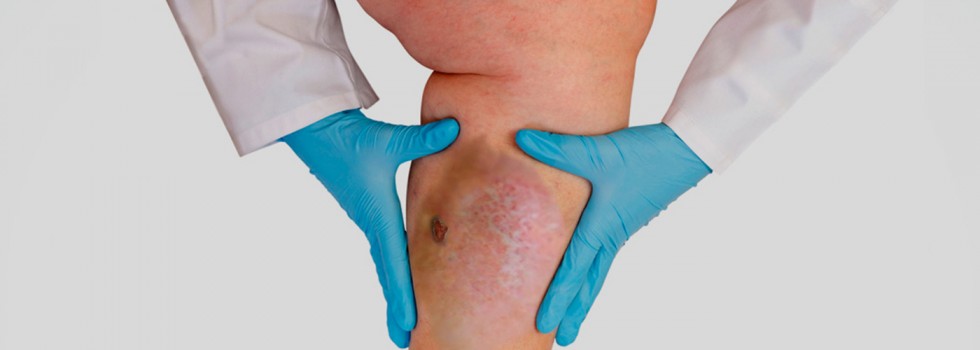Venous Ulcers
What are Venous Ulcers?
Venous ulcers can become large and stubborn to heal. They are associated with other signs of venous hypertension and insufficiency such as varicose veins, eczema, pigmentation and venous flare. Oedema of the lower leg may affect the area and can lead to skin irritation, the development of lesions and scarring. Venous ulcers are caused by incompetent or malfunctioning valves in the veins of the lower leg, especially in the perforators. These incompetent valves cause blood to be pushed out into the superficial veins when the calf muscles contract, instead of upwards towards the heart. Dilation of the superficial veins (varicosities) occurs and the resulting raised venous pressure results in oedema, appearance of veins, eczema and ulceration. The valves can also become damaged as a result of the venous hypertension that occurs in pregnant women or the valves may be congenitally missing.
People who have previously had an ulcer have a risk of developing it again. Once a leg has suffered a
venous ulcer, there is a one in four chance of developing further ulceration within two years of the occurrence.
The Causes of Venous Ulcers
-
VARICOSE VEINS
-
DIABETES
-
OBESITY
-
ARTERIAL DISEASE
-
VENOUS REFLUX DISEASE
-
THROMBOSIS (DVT)
The Treatment of Venous Ulcers
Venous insufficiency which leads to venous hypertension of the lower extremities, is not uncommon and is not asymptomatic. It can cause many unpleasant symptoms including venous ulcers. When left untreated, venous hypertension can cause the skin tissue to break down and the nonhealing venous ulcers eventually develop. Venous leg ulcers are a serious symptom of an advanced stage of chronic venous insufficiency (CVI). Leg ulceration is estimated to affect 1% of the adult population.
Radiofrequency Ablation(RFA)
Endovenous Radiofrequency Ablation (RFA), also known as the VNUS/VENEFIT is considered a modern marvel in the world with respect to treatment of vein disorders. Prior to this incredible innovation, treating problem veins involved major surgery and an extended recovery period. Commonly known as “vein stripping” and “stab avulsion,” the technique is designed to remove diseased veins by surgically cutting and pulling them out under general anaesthesia. A long, painful recovery and scarring from this surgery discouraged many people from seeking any treatment at all. The fact is that, today, varicose veins can be treated in less than an hour with RFA. Recovery from RFA is about a day and the results are permanent with the chances of reoccurrence being less than 1%, as shown in numerous clinical trials. In fact, patients walk away from the procedure. RFA is covered by most medical aids in South Africa. For more information, see the video presentation.Read More
Sclerotherapy
Sclerotherapy refers to a treatment consisting of a sequence of injections of a solution into the lumen of a spider vein, perforator vein, larger varicosity or occasionally, a varicose vein. This solution causes the vein wall to close off. This treatment usually consists of more than one session, typically 2 or 3 but can require any number of sessions up to approximately 10 sessions, spaced roughly 1 to 2 months apart. Sometimes, one session is adequate, depending on the extensity of the progression or appearance of the cosmetic damage. Sclerotherapy has been used in the treatment for more than 100 years. As with varicose vein surgery, sclerotherapy techniques have also advanced during that time. Sclerotherapy is a very effective treatment that is used to dissipate abnormal spider veins and smaller cosmetic varicosities. It is used both aesthetically, to treat unsightly veins, and medicinally, to treat defective veins which are causing poor circulation and skin problems. The main progression in sclerotherapy has been the introduction of safer and more effective sclerosing solutions that have less side effects such as burning or pain as they are injected.Read More


